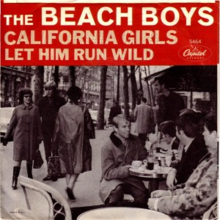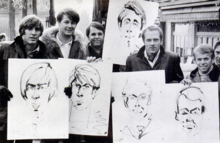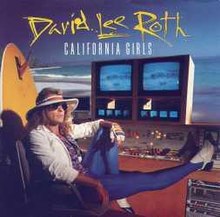
The Beach Boys are an American rock band formed in Hawthorne, California, in 1961. The group's original lineup consisted of brothers Brian, Dennis, and Carl Wilson, their cousin Mike Love, and friend Al Jardine. Distinguished by their vocal harmonies, adolescent-oriented lyrics, and musical ingenuity, they are one of the most influential acts of the rock era. They drew on the music of older pop vocal groups, 1950s rock and roll, and black R&B to create their unique sound. Under Brian's direction, they often incorporated classical or jazz elements and unconventional recording techniques in innovative ways.

Brian Douglas Wilson is an American musician, singer, songwriter, and record producer who co-founded the Beach Boys. Often called a genius for his novel approaches to pop composition, extraordinary musical aptitude, and mastery of recording techniques, he is widely acknowledged as one of the most innovative and significant songwriters of the 20th century. His best-known work is distinguished for its high production values, complex harmonies and orchestrations, layered vocals, and introspective or ingenuous themes. Wilson is also known for his formerly high-ranged singing and for his lifelong struggles with mental illness.

Bruce Arthur Johnston is an American singer, musician, and songwriter who is a member of the Beach Boys. He also collaborated on many records with Terry Melcher and composed the 1975 Barry Manilow hit, "I Write the Songs".

Sunflower is the 16th studio album by the American rock band the Beach Boys, released on August 31, 1970 on Reprise Records, their first for the label. It received favorable reviews, but sold poorly, reaching number 151 on the US record charts during a four-week stay and becoming the lowest-charting Beach Boys album to that point. "Add Some Music to Your Day" was the only single that charted in the US, peaking at number 64. In the UK, the album peaked at number 29.

The Beach Boys Today! is the eighth studio album by the American rock band the Beach Boys, released March 8, 1965, by Capitol Records. It signaled a departure from their previous records with its orchestral sound, intimate subject matter, and abandonment of car or surf songs. Side one features an uptempo sound, while side two consists mostly of introspective ballads. Supported by this thematic approach, the record became an early example of a rock concept album and established the group as album artists rather than just a singles band. It has since become regarded as one of the greatest albums of all time.

Holland is the 19th studio album by American rock band the Beach Boys, released January 8, 1973 on Brother/Reprise. It is their first album recorded without Bruce Johnston since 1965, their second with Blondie Chaplin and Ricky Fataar, and their final studio album created under the de facto leadership of Carl Wilson and manager Jack Rieley. The LP was originally packaged with a bonus EP, Mount Vernon and Fairway, which consisted of a 12-minute fairy tale written and produced by Brian and Carl Wilson.

Carl and the Passions – "So Tough" is the 18th studio album by American rock band the Beach Boys, released May 15, 1972 on Brother/Reprise. The album is a significant musical departure for the band and is the first to feature the Flames' Blondie Chaplin and Ricky Fataar as additions to their official line-up. It sold poorly and was met with lukewarm reviews, but later gained stature as a cult favorite among fans.

15 Big Ones is the 20th studio album by the American rock band the Beach Boys, released July 5, 1976, by Brother/Reprise. It includes a mix of original songs and renditions of rock 'n' roll and R&B standards. The LP was the band's first album with production credited solely to Brian Wilson since Pet Sounds (1966). As such, its release was accompanied by a controversial media campaign that declared his comeback as an active member of the Beach Boys' recording and touring group.

The Beach Boys Love You is the 21st studio album by American rock band the Beach Boys, released April 11, 1977, on Brother/Reprise. Sometimes called the band's "punk" or "synth-pop" album, Love You is characterized for its pioneering use of synthesizers and its juxtaposition of adolescent-oriented lyrics with the adult band members' gravelly vocals.
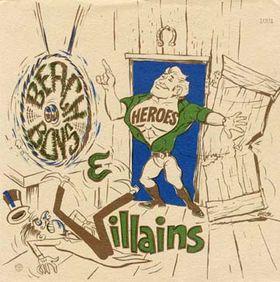
"Heroes and Villains" is a song by the American rock band the Beach Boys from their 1967 album Smiley Smile and their unfinished Smile project. Written by Brian Wilson and Van Dyke Parks, Wilson envisioned the song as an Old West-themed musical comedy that would surpass the recording and artistic achievements of "Good Vibrations". The single was Brother Records' first release. While it failed to meet critical and commercial expectations, it was a hit record, peaking at number 12 in the U.S. and number 8 in the UK.

All Summer Long is the sixth album by the American rock band the Beach Boys, released July 13, 1964 on Capitol Records. Regarded as their first artistically unified collection of songs, as well as one of the first true concept albums, it marked the Beach Boys' first LP that was not focused on themes of cars or surfing. Instead, the songs are semi-autobiographical and relate to the experiences of a typical Southern Californian teenager, a theme encapsulated by the title track, "All Summer Long", and the often-imitated front cover, a modernist style photo collage depicting the band members fraternizing with young women on a beach.
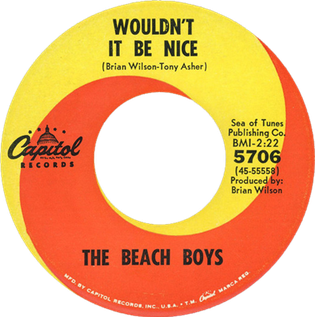
"Wouldn't It Be Nice" is a song by the American rock band the Beach Boys and the opening track from their 1966 album Pet Sounds. Written by Brian Wilson, Tony Asher, and Mike Love, it is distinguished for its sophisticated Wall of Sound-style arrangement and refined vocal performances, and is regarded among the band's finest songs. With its juxtaposition of joyous-sounding music and melancholic lyrics, it is considered a formative work of power pop, and with respect to musical innovation, progressive pop.
"You Still Believe in Me" is a song by American rock band the Beach Boys from their 1966 album Pet Sounds. Initially conceived as "In My Childhood", it was the first songwriting collaboration between Brian Wilson, the group's de facto leader, and songwriter Tony Asher. Wilson sang the lead vocal.
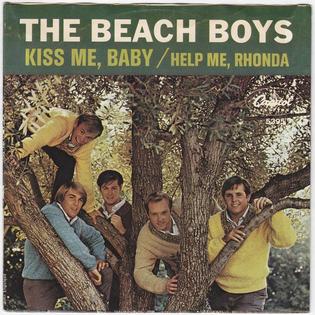
"Kiss Me, Baby" is a song by the American rock band the Beach Boys from their 1965 album The Beach Boys Today!. Written by Brian Wilson and Mike Love, it was issued as the B-side of the group's "Help Me, Rhonda" single on April 5.

"Don't Worry Baby" is a song by American rock band the Beach Boys from their March 1964 album Shut Down Volume 2. Written by Brian Wilson and Roger Christian, Wilson's lead vocal on the track is considered one of his defining performances, and he later referred to "Don't Worry Baby" as perhaps the Beach Boys' finest record. It was issued in May 1964 as the B-side of "I Get Around", and charted separately at number 24.

"Please Let Me Wonder" is a song by the American rock band the Beach Boys from their 1965 album The Beach Boys Today!. Written by Brian Wilson and Mike Love, it was the first song Wilson wrote under the influence of marijuana. The lyrics are about a man who does not know if a girl loves him and is afraid of learning the answer, and so he prefers to fantasize that she does. On February 15, the song was issued as the B-side to their "Do You Wanna Dance?" single before the album's release.
"Wonderful" is a song by the American rock band the Beach Boys from their 1967 album Smiley Smile and their unfinished Smile project. Written by Brian Wilson and Van Dyke Parks, it was their only collaboration that resulted in a love song, telling the story of a young girl's sexual awakening and its disruption of her devotion to God and her parents.

"Add Some Music to Your Day" is a song by American rock band the Beach Boys that was released in the US on February 23, 1970 as the lead single from their album Sunflower. It was written by Brian Wilson, Joe Knott, and Mike Love. Wilson later said that Knott "was a friend of mine who wasn't a songwriter but he contributed a couple of lines. But I can't remember which ones!"

"The Little Girl I Once Knew" is a song by the American rock band the Beach Boys that was issued as a standalone single on November 22, 1965. Written and produced by Brian Wilson, it was recorded during the making of the band's 1966 album Pet Sounds.

"I Get Around" is a song by American rock band the Beach Boys and the opening track from their 1964 album All Summer Long. Written by Brian Wilson and Mike Love, the autobiographical lyrics describe the group's reaction to their newfound fame and success, as well as their restlessness concerning the status quo, and their desire to find new places "where the kids are hip". It was released as a single on May 11, 1964, with the B-side "Don't Worry Baby".
